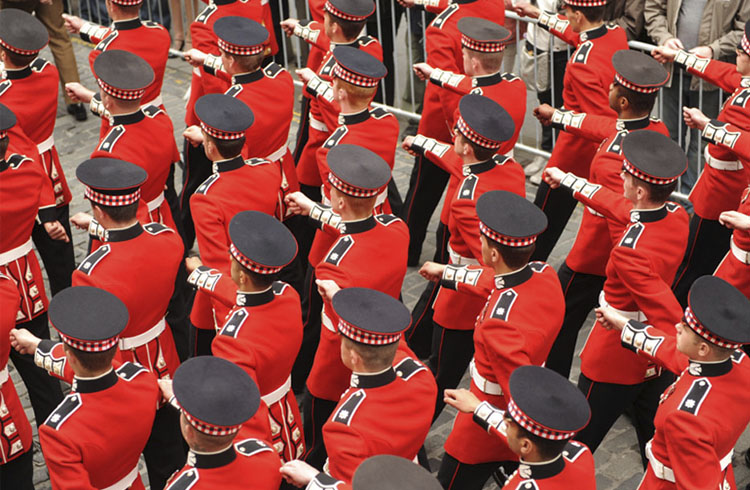
The Scots Guards are one of the oldest and most esteemed regiments in the British Army, celebrated for their long history, ceremonial roles, and distinguished operational service. As one of the five regiments of Foot Guards, they play a crucial part in both state ceremonies and military operations, embodying a rich tradition of service and excellence.
Historical Background
The Scots Guards were officially formed in 1642 by Sir Archibald Campbell, the 1st Marquess of Argyll, as part of the Scottish Army. Originally known as the “Marquess of Argyll’s Royal Regiment,” they were created to serve in the Civil War and subsequently became part of the British Army in 1686 under King James II. Their early service included participation in the War of Spanish Succession, the Battle of Malplaquet, and various other 18th-century conflicts, marking the beginning of a storied military history.
The regiment’s motto, “Nemo Me Impune Lacessit” (No One Provokes Me With Impunity), reflects their fierce fighting spirit and unwavering resolve. Throughout their history, the Scots Guards have been involved in numerous key military campaigns, including the Napoleonic Wars, the Crimean War, both World Wars, and more recent conflicts in the Falklands, Iraq, and Afghanistan.
Ceremonial Duties
The Scots Guards are prominently known for their ceremonial duties, a significant aspect of their service within the Household Division. They are one of the regiments responsible for guarding the royal residences, including Buckingham Palace, St. James’s Palace, and the Tower of London. Their most visible duty is the Changing of the Guard ceremony, which is a major attraction for tourists and a symbol of the continuity of the British monarchy.
Their ceremonial dress includes the iconic red tunics and bearskin hats, which are instantly recognizable and symbolize British military tradition. The precision and discipline displayed by the Scots Guards during these ceremonies reflect their dedication to upholding the highest standards of military protocol and decorum.
Operational Role
Beyond their ceremonial roles, the Scots Guards are a highly capable operational infantry regiment. Their training prepares them for a wide array of military operations, from peacekeeping missions to full-scale combat. The regiment’s versatility and adaptability are essential to the British Army’s rapid deployment and operational effectiveness.
In recent years, the Scots Guards have been deployed in various conflict zones, showcasing their operational capabilities. They have served in Northern Ireland during the Troubles, participated in peacekeeping operations in Bosnia and Kosovo, and been involved in combat operations in Iraq and Afghanistan. These deployments highlight their ongoing commitment to international security and their ability to operate in diverse and challenging environments.
Training and Recruitment
Training for the Scots Guards is thorough and demanding, ensuring that every soldier is well-prepared for both ceremonial and operational duties. Recruits undergo the standard 14-week British Army basic training before progressing to the Infantry Training Centre in Catterick for the Combat Infantry Course. This training includes weapons handling, tactical maneuvers, physical fitness, and ceremonial drill.
Recruitment into the Scots Guards is competitive, with an emphasis on selecting individuals who demonstrate physical endurance, mental resilience, and a strong sense of duty. The regiment attracts recruits from across the United Kingdom and the Commonwealth, fostering a diverse and inclusive environment that enhances its operational effectiveness.
Cultural Impact and Legacy
The Scots Guards have made a lasting cultural impact, symbolizing the valor and tradition of the British Army. Their presence at state events, such as royal weddings, state funerals, and the annual Trooping the Colour, underscores their role as key figures in the ceremonial life of the nation. The regiment’s music, particularly their regimental march “Hielan’ Laddie,” has become an integral part of British military and cultural heritage.
Their legacy is also marked by notable members, including various members of the British royal family who have served with the regiment, underscoring its close ties to the monarchy. The Scots Guards’ motto, “Nemo Me Impune Lacessit,” reflects their ethos of honor and resilience.
Conclusion
The Scots Guards epitomize the blend of tradition and modernity that defines the British Army. From their origins in the 17th century to their current roles, they embody a unique combination of historical significance, ceremonial grandeur, and operational capability. Their commitment to serving the Crown and country ensures that they remain a vital part of Britain’s military and cultural landscape, embodying their motto “No One Provokes Me With Impunity” in every aspect of their service.